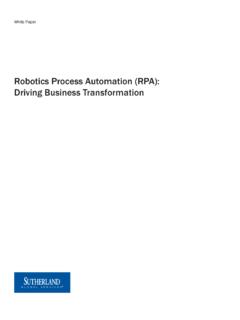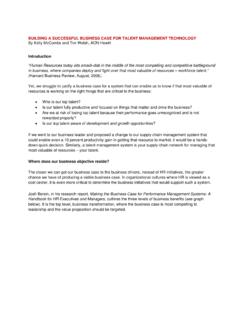Transcription of Andrea Bassanini and Stefano Scarpetta - OECD.org
1 OECD Economic Studies No. 33, 2001/II 9 OECD 2001 THE driving FORCES OF ECONOMIC GROWTH: PANEL DATA EVIDENCE FOR THE OECD COUNTRIESA ndrea Bassanini and Stefano ScarpettaTABLE OF CONTENTSI ntroduction ..10 The determinants of economic determinants of growth: the accumulation of physical and human capital ..13 Research and policy setting and growth ..16 Financial development and growth ..20 International trade and growth ..20 Specification of the growth equation and estimation technique ..21 The estimated growth equations ..21 The econometric technique.
2 23 Regression results and role of convergence and capital accumulation in the growth role of macroeconomic policy and institutions on growth ..27 Research and and institutional influences on capital accumulation ..32 Some quantitative implications of the regression results ..34 The long-run effect of policy and institutional changes ..34 Explaining cross-country differences in average growth rates ..36 The role of policy and institutions in shaping the growth process over the past two decades ..39 Concluding remarks ..39 Appendix Policy-and-Institutions Augmented Growth Model.
3 47 Appendix data ..50 Bibliography ..53 The authors wish to thank Phillip Hemmings for his help in comparing the present results with those inthe empirical literature, and Catherine Chapuis-Grabiner for excellent statistical assistance. SanghoonAhn, Sven Bl ndal, Gavin Cameron, J rgen Elmeskov, Michael Feiner, Dirk Pilat, Ron Smith, JonathanTemple, Nicholas Vanston and Ignazio Visco also provided many helpful comments. A previous versionof this paper was presented at the "S minaire d'Economie Mon taire Internationale", Paris, 24 November 2000(CEPREMAP, DELTA) and at the 16th Annual Congress of the European Economic Association, 29 Augustto 1 September 2001, and we acknowledge useful comments from participants.
4 The opinions expressedin the paper are those of the authors and do not necessarily reflect those of the OECD or its Membercountries. 10 OECD 2001 INTRODUCTIONThe past decade has witnessed a renewed interest in the main factors drivingeconomic growth in the OECD countries. A few countries including the UnitedStates, the technology leader have experienced an acceleration in growth ofGDP per capita, but other major economies have lagged behind, raising questionsas to the role of technological progress as well as policy and institutions.
5 Thispaper aims at shedding some light on these issues by presenting evidence on thelong-term links between policy settings, institutions and economic growth inOECD countries while controlling for underlying differences in technologicalprogress. In particular, the focus is two-fold: first, on the possible influences ofhuman capital, research and development activity, macroeconomic and structuralpolicy settings, trade policy and financial market conditions on economic effi-ciency; second, on the effects of many of the same factors on the accumulation ofphysical empirical studies support the relevance of these factors for economicgrowth, this literature often relies on a large set of countries, including many non-OECD economies and, once constrained to the OECD sample, results are oftenunsatisfactory (Temple, 1999).
6 The cross-country variability in both growth pat-terns and potential explanatory variables is much smaller if one focuses on theOECD sub-sample. Hence, data quality and the estimation approach assume aneven more crucial role in the empirical analysis. We tackle both issues by usingharmonised OECD data and a novel econometric approach that reconciles growthmodel assumptions with available in a number of recent studies, we use pooled cross-country time-seriesdata in order to explain both cross-country differences in growth performance aswell as the evolution of performance over time in each country.
7 In addition, oureconometric technique allows short-term adjustments and convergence speeds tovary across countries while imposing (and testing) restrictions only on long-runcoefficients ( related to the production function). To anticipate the mainresults of this study, we find the accumulation of physical as well as human capitalto be the main drivers of economic growth. In addition, R&D activity, a sound mac-roeconomic environment, trade openness and well-developed financial marketscontribute to raise living standard in OECD countries.
8 Some of the same factorsThe driving Forces of Economic Growth: Panel Data Evidence for the OECD Countries 11 OECD 2001that operate directly on growth also influence it indirectly via the mobilisation ofresources for fixed paper is organised as follows. In the first section, we briefly introduce thepolicies and institutional dimensions that are considered in the empirical investi-gation of the sources of economic growth. The section focuses on the transmissionmechanisms linking policy to growth as well as on cross-country differences inpolicy settings and their evolution over time.
9 The institutional and policy vari-ables considered have three basic characteristics: i)they are largely macroeco-nomic in nature; ii)they yield testable implications for economic growth; andiii)they can be evaluated using available data across countries and over time. Inthe second section we introduce the estimated growth equation and discuss theeconometric approach used in the regressions. The third section presents theeconometric results. The estimated coefficients from the growth regressions arealso used in the fourth section to assess the role of different policy settings inthe evolution of growth both over time and across the OECD countries.
10 The finalsection DETERMINANTS OF ECONOMIC GROWTHThe literature on economic growth is vast and policy-oriented studies, in par-ticular, have flourished in the past decade (see Temple, 1999 and Ahn andHemmings, 2000 for surveys). Yet, there is little agreement on the exact mecha-nisms linking policy settings to growth. For example, if one assumes, consistentwith the traditional neo-classical growth model, diminishing returns to reproduc-ible factors and exogenous saving rates, population growth and technologicalprogress, then policies have no role in shaping long-term economic growth.

















